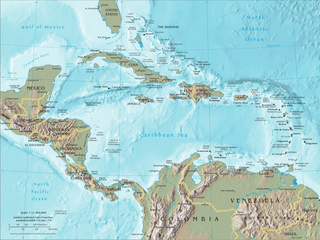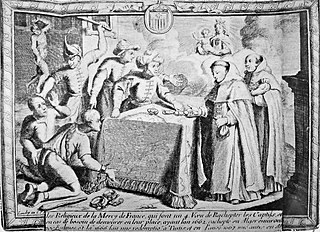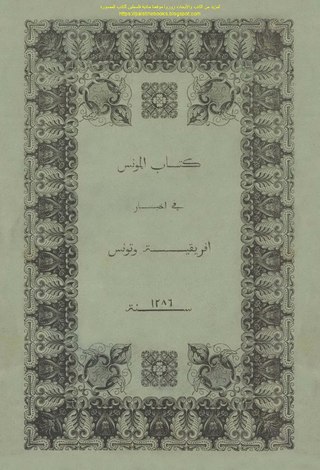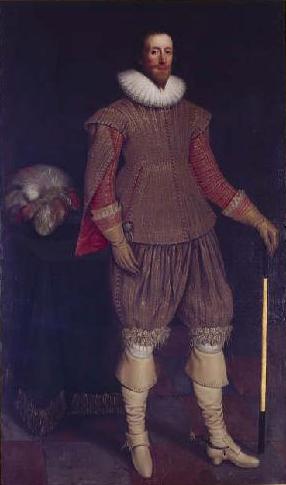Related Research Articles

A privateer is a private person or vessel which engages in maritime warfare under a commission of war. Since robbery under arms was a common aspect of seaborne trade, until the early 19th century all merchant ships carried arms. A sovereign or delegated authority issued commissions, also referred to as letters of marque, during wartime. The commission empowered the holder to carry on all forms of hostility permissible at sea by the usages of war. This included attacking foreign vessels and taking them as prizes and taking crews prisoner for exchange. Captured ships were subject to condemnation and sale under prize law, with the proceeds divided by percentage between the privateer's sponsors, shipowners, captains and crew. A percentage share usually went to the issuer of the commission.

The era of piracy in the Caribbean began in the 1500s and phased out in the 1830s after the navies of the nations of Western Europe and North America with colonies in the Caribbean began hunting and prosecuting pirates. The period during which pirates were most successful was from the 1660s to the 1730s. Piracy flourished in the Caribbean because of the existence of pirate seaports such as Port Royal in Jamaica, Tortuga in Haiti, and Nassau in the Bahamas. Piracy in the Caribbean was part of a larger historical phenomenon of piracy, as it existed close to major trade and exploration routes in almost all the five oceans.

Condent, born in Plymouth in Devon, was an English pirate who was best known for his piracies in the Indian Ocean.
Peter Easton was an English privateer and later pirate in the early 17th century. Conflicting accounts exist regarding his early life. By 1602, Easton had become a highly successful privateer, commissioned to protect English interests in Newfoundland. The 'most famous English pirate of the day', his piracies ranged from Ireland and Guinea to Newfoundland. He is best known today for his involvement in the early English settlement of Newfoundland, including the settlements at Harbour Grace and Ferryland from 1611 to 1614. One of the most successful of all pirates, he controlled such seapower that no sovereign or state could afford to ignore him, and he was never overtaken or captured by any fleet commissioned to hunt him down. However, he is not as well known as some of the pirates from the late 17th and early 18th centuries.

The Barbary pirates, Barbary corsairs, or Ottoman corsairs were mainly Muslim pirates and privateers who operated from the Barbary states. This area was known in Europe as the Barbary Coast, in reference to the Berbers. Slaves in Barbary could be of many ethnicities, and of many different religions, such as Christian, Jewish, or Muslim. Their predation extended throughout the Mediterranean, south along West Africa's Atlantic seaboard and into the North Atlantic as far north as Iceland, but they primarily operated in the western Mediterranean. In addition to seizing merchant ships, they engaged in razzias, raids on European coastal towns and villages, mainly in Italy, France, Spain, and Portugal, but also in the British Isles, the Netherlands, and Iceland.

Woodes Rogers was an English sea captain, privateer and colonial administrator who served as the governor of the Bahamas from 1718 to 1721 and again from 1728 to 1732. He is remembered as the captain of the vessel that rescued marooned Scottish sailor Alexander Selkirk, whose plight is generally believed to have inspired Daniel Defoe's novel Robinson Crusoe. Rogers came from an experienced seafaring family, grew up in Poole and Bristol, and served a marine apprenticeship to a Bristol sea captain. His father held shares in many ships, but he died when Rogers was in his mid-twenties, leaving Rogers in control of the family shipping business.
John Ward, also known as Birdy or later as Yusuf Reis, was an English pirate who later became a Corsair for the Ottoman Empire operating out of Tunis during the early 17th century.
John Taylor, born Richard Taylor, was an English pirate active in the Indian Ocean, best known for participating in two of the richest pirate captures of all time.
Jeremiah Cocklyn, better known by the name Thomas Cocklyn, was an English pirate known primarily for his association with Howell Davis, Olivier Levasseur, Richard Taylor, and William Moody.
Jan Janszoon van Haarlem, commonly known as Reis Mourad the Younger, was a Dutch pirate who later became a Barbary corsair in Ottoman Algeria and the Republic of Salé. After being captured by Algerian corsairs off Lanzarote in 1618, he converted to Islam and changed his name to Mourad. He became one of the most famous of the 17th-century Barbary corsairs. Together with other corsairs, he helped establish the independent Republic of Salé at the city of that name, serving as the first President and Commander. He also served as Governor of Oualidia.
See also 1719 in piracy, 1721 in piracy and Timeline of piracy.

The Barbary slave trade, part of the Arab slave trade, involved the capture and selling of European slaves at slave markets in the Barbary states. European slaves were captured by Barbary pirates in slave raids on ships and by raids on coastal towns from Italy to the Netherlands, Ireland and the southwest of Britain, as far north as Iceland and into the Eastern Mediterranean.
Sir Henry Mainwaring (1587–1653), was an English lawyer, soldier, writer, seaman and politician who sat in the House of Commons from 1621 to 1622. He was for a time a pirate based in Newfoundland and then a naval officer with the Royal Navy. He supported the Royalist cause in the English Civil War.

Siemen Danziger, better known by his anglicized names Zymen Danseker and Simon de Danser, was a 17th-century Dutch privateer and Barbary corsair based in Ottoman Algeria. His name is also written Danziker, Dansker, Dansa or Danser.

Anglo-Turkish piracy or the Anglo-Barbary piracy was the collaboration between Barbary pirates and English pirates against Catholic shipping during the 17th century.

Sir Francis Verney was an English adventurer, soldier of fortune, and pirate. A nobleman by birth, he left England after the House of Commons sided with his stepmother in a legal dispute over his inheritance, and became a mercenary in Morocco and later a Barbary corsair.
Samuel Inless was a pirate captain in the Indian Ocean, best known for serving as Captain over Nathaniel North and George Booth.

The Proclamation for Suppressing of Pirates was a royal proclamation issued by George I of Great Britain on 5 September 1717. It promised a pardon for acts of piracy committed before the following 5 January to those pirates who surrendered themselves to the correct authority before a deadline. Originally, the surrender had to occur on or before 5 September 1718; this was later extended by a second proclamation to 1 July 1719.

Acts of grace, in the context of piracy, were state proclamations offering pardons for acts of piracy. General pardons for piracy were offered on numerous occasions and by multiple states, for instance by the Kingdom of England and its successor, the Kingdom of Great Britain, in the 17th and 18th centuries.
This timeline of the history of piracy in the 1600s is a chronological list of key events involving pirates between 1600 and 1609.
References
- 1 2 3 4 5 6 7 8 9 10 11 12 Tinniswood, Adrian (2010). Pirates of Barbary: corsairs, conquests, and captivity in the seventeenth-century Mediterranean. New York: Riverhead Books. ISBN 9781594487743.
- ↑ "Pirates of the Hebrides and the execution of Captain Peter Love". The Scotsman. 13 February 2017. Retrieved 11 July 2022.
- ↑ "South Land to New Holland - The Seynbrief". 2011-03-21. Archived from the original on 2011-03-21. Retrieved 2022-07-13.
- ↑ Butts, Edward (16 January 2008). "Sir Henry Mainwaring". The Canadian Encyclopedia. Retrieved 11 July 2022.
- 1 2 Clive Malcolm Senior, An Investigation of the Activities and Importance of English Pirates, 1603-40 (University of Bristol, PhD thesis, 1973), p. 88-91
- 1 2 Burns, Alan. History of the British West Indies. Allen & Unwin. OCLC 557499386.
- ↑ "Knights of England". Internet Archive. Retrieved 11 July 2022.